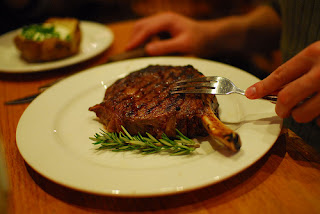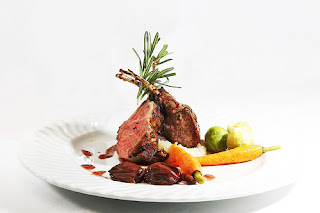The French diner, with his or her native language skills, will understand the meaning of the accents over and under letters and the masculine, feminine and plural variations that may appear on a menu. For visitors with only high-school French, the gender-linked variations alone can be a problem. However, when dining in French restaurants, where many printed menus ignore the accents there will rarely be any problems.
Côte and
Côtes
Bone-In
Rib Steak/s, a Rib Roast, a Cutlet/s or a Chop/s and Vegetable Ribs:
Côte on French menus:
Côte
d'Agneau Grillees Sauce Paloise – Grilled lamb chop served with a Sauce Paloise. Sauce Paloise is a child of Sauce Bearnaise where the tarragon has been replaced by mint.
Côte de Bœuf, Frottée au Romarin et
Cuite au Beurre Noisette – A bone-in beef rib steak flavored with rosemary and cooked in a beurre noisette. When ordering ask the weight as a single portion will often be intended for two diners, and the bone is generally 50-60% of the total weight. A Beurre Noisette is a melted butter sauce where the butter has been allowed to cook until its color and taste resembles noisettes, hazelnuts.
Côte de Veau
Rôtie au Jus, Beurre,
Herbes - A veal bone-in, roasted, rib steak served with a sauce made from the natural cooking juices flavored with butter and herbs.
Côtes
The
plural of Côte:
Côtes on French menus:
Côtes de Bœuf de Charolais, Grillée à l'Os - A grilled bone-in beef rib roast from France’s famed Charolais beef.
Côtes de Porc Laquées – Glazed pork chops; they will have been basted in a honey or a fruit coating. Pork spareribs would be on the menu as echine de porc or travers de porc
Côté
Côté also indicates a side or a part, and your menu may offer:
Côté de Saumon Grillée
à l’Orange. A
salmon filet grilled with an orange sauce. N.B. The same spelling is used
when describing something that is close by, in French that's à côté.
A bone-in rib roast.
Côtes
May also
indicate the ribs of vegetables.
Aligot au
Fromage de Laguiole,
Verts et Côtes de Blettesettes– The traditional and uniquely tasty Aligot dish of mashed potatoes and Laguiole cheese. Here, the dish is served with the leaves and côtes, ribs, of Swiss chard.
Côtelette
A cutlet
or chops.
The word côtelette or côte may be used interchangeably when referring to chops; though the use of the word côtelettes, cutlets, usually indicates smaller cuts. The menu may offer cutlets from pork, veal or lamb, but not from beef.
Côtelette de Porc Noir – A pork chop from the Porc Noir Gascon, the black pigs of Gascony.
Côtelettes
d'Agneau - Lamb chops
www.flickr.com/photos/30216515@N05/6923392679/
Nos
Côtes
Our
coasts, and the fish and seafood that may be caught there.
On fish and seafood menus, the word côte or côtes indicates the coast, and fish and seafood caught off that coast.
Le Pavé de Cabillaud des Côtes Normande Rôti – A large cut from a cod caught off our Normandy coast, served roasted.
Roast
Cod.
www.flickr.com/photos/sodexousa/5781078553/
Langouste de Nos Côtes Bretonnes Rôti ou
Grillé, Pistou de Basilic - Rock lobster, the owner of the lobster tail, from our Brittany coasts roasted or grilled and served with a basil pistou basil sauce. The French pistou sauce appeared not long after the Italian pesto; they are close cousins.
Langouste
- Lobster Tail.
Wines:
Wine-lists may
carry the word Côte as part of a wine's name; then Côtes will indicate the
hills, slopes, valleys within the borders of a wine appellation, a wine-growing
area.
Côtes de Provence AOP - This is the AOP for wines coming from specific wine-growing areas in Provence. The Côtes de Provence wines include red and white wines; however, more than half the wines produced are rosés.
Côtes du Rhône AOC/AOP – AOP wines from France’s Rhône Valley that include reds, rosés and some white wines. This is an enormous wine growing area that stretches for over 200 km (115 miles) from the North to the South of the Rhone valley along the River Rhône. Other appellations within the Côtes du Rhône include the famous Château-Neuf-de Pape, and the Muscat de Beaumes-de-Venise one of France’s most famous fortified wines, as well as the Côtes du Rhône-Villages AOP wines, and the less well known, but unique pre-Champagne, sparkling-wine called the Clairette de Die AOP.
Côtes du
Rhône Rosé
Côtières
Coastal. On your menu for fish and seafood caught locally.
The Coast of
Brittany.
The multi-colored
cliffs of the Cap Frehel along the Côtes d'Armor, Northern Brittany.
Coteau and Coteaux
A hillside or
hillsides
Coteaux-du-Quercy AOP - An appellation for red and rosé wines in the old province of Quercy between the Cahors vineyards and the vines that produce the Chasselas de Moissac AOP table grapes in southwest France.
Behind the French Menu
--------------------------------
Behind the French Menu
by
Bryan G. Newman
behindthefrenchmenu@gmail.com
Copyright 2010, 2014, 2019, 2020
--------------------------------
Searching for the meaning of words, names or phrases
on
French menus?
Just add
the word, words, or phrase that you are searching for to the words "Behind
the French Menu" (best when including the inverted commas), and search with
Google, Bing, or another browser. Behind the French Menu’s links,
include hundreds of words, names, and phrases that are seen on French menus.
There are over 450 articles that include over 4,000 French dishes with English
translations and explanations.
Connected Posts:
















